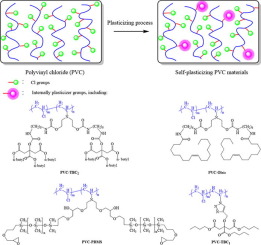当前位置:
X-MOL 学术
›
Eur. Polym. J.
›
论文详情
Our official English website, www.x-mol.net, welcomes your
feedback! (Note: you will need to create a separate account there.)
Internally Plasticized PVC by Four Different Green Plasticizer Compounds
European Polymer Journal ( IF 5.8 ) Pub Date : 2020-04-01 , DOI: 10.1016/j.eurpolymj.2020.109620 Vahid Najafi , Hossein Abdollahi
European Polymer Journal ( IF 5.8 ) Pub Date : 2020-04-01 , DOI: 10.1016/j.eurpolymj.2020.109620 Vahid Najafi , Hossein Abdollahi

|
Abstract In this work, the phthalate-free internally plasticized polyvinyl chloride (PVC) materials were developed by covalent attachment of tributyl citrate (TBC), propargyl ether tributyl citrate (PrTBC), oleic acid, and poly(dimethylsiloxane) diglycidyl ether terminated (PDMS, Mn ≃ 800) to the PVC matrix. The obtained modified PVC (M-PVC) materials through different synthesis routes abbreviated with PVC-TBC1, PVC-TBC2, PVC-Oleic, and PVC-PDMS, respectively. The M-PVCs were characterized by FT-IR, 1H NMR, GPC, TGA, DSC, tensile and migration stability tests. The TGA thermograms indicate the M-PVC materials, especially PVC-PDMS and PVC-Oleic, have higher thermal stability than PVC. The internally plasticized PVCs show the lower Tg compared to PVC. The Tg of the neat PVC is 84 °C, meanwhile, the Tg of the PVC-PDMS, PVC-TBC1, PVC-Oleic, and PVC-TBC2 were decreased to 62.6, 53.0, 42.8, and 41.0 °C, respectively. By substitution of chlorine atom with plasticizers, tensile strength decreased from 41.35 MPa down to 25.01 MPa and the elongation at break increased from 40.80% up to 90.27%. Besides, no migration was observed for these M-PVCs in petroleum ether, 30% (w/v) acetic acid, 10% (v/v) ethanol, and distilled water. Hence, the results showed that plasticization of the PVC was successfully performed by these covalent plasticization without any migration. These strategies are expected to be scalable, and provide a viable alternative to the use of phthalates, thus decrease the human health threat and environmental risks.
中文翻译:

四种不同绿色增塑剂化合物内部增塑 PVC
摘要 在这项工作中,通过将柠檬酸三丁酯 (TBC)、炔丙基醚柠檬酸三丁酯 (PrTBC)、油酸和聚二甲基硅氧烷二缩水甘油醚封端 (PDMS) 共价连接,开发了不含邻苯二甲酸酯的内增塑聚氯乙烯 (PVC) 材料。 , Mn ≃ 800) 到 PVC 基体。通过不同合成路线获得的改性PVC(M-PVC)材料分别缩写为PVC-TBC1、PVC-TBC2、PVC-Oleic和PVC-PDMS。M-PVC 通过 FT-IR、1H NMR、GPC、TGA、DSC、拉伸和迁移稳定性测试进行表征。TGA 热分析图表明 M-PVC 材料,尤其是 PVC-PDMS 和 PVC-Oleic,具有比 PVC 更高的热稳定性。与 PVC 相比,内部增塑的 PVC 显示出较低的 Tg。纯 PVC 的 Tg 为 84 °C,同时,PVC-PDMS、PVC-TBC1、PVC-Oleic、和 PVC-TBC2 分别降至 62.6、53.0、42.8 和 41.0 °C。通过用增塑剂取代氯原子,拉伸强度从41.35 MPa下降到25.01 MPa,断裂伸长率从40.80%上升到90.27%。此外,这些 M-PVC 在石油醚、30% (w/v) 乙酸、10% (v/v) 乙醇和蒸馏水中未观察到迁移。因此,结果表明通过这些共价增塑成功地进行了 PVC 的增塑,而没有任何迁移。这些策略预计具有可扩展性,并为邻苯二甲酸酯的使用提供可行的替代方案,从而减少人类健康威胁和环境风险。35 MPa 下降到 25.01 MPa,断裂伸长率从 40.80% 增加到 90.27%。此外,这些 M-PVC 在石油醚、30% (w/v) 乙酸、10% (v/v) 乙醇和蒸馏水中未观察到迁移。因此,结果表明通过这些共价增塑成功地进行了 PVC 的增塑,而没有任何迁移。这些策略预计具有可扩展性,并为邻苯二甲酸酯的使用提供可行的替代方案,从而减少人类健康威胁和环境风险。35 MPa 下降到 25.01 MPa,断裂伸长率从 40.80% 增加到 90.27%。此外,这些 M-PVC 在石油醚、30% (w/v) 乙酸、10% (v/v) 乙醇和蒸馏水中未观察到迁移。因此,结果表明通过这些共价增塑成功地进行了 PVC 的增塑,而没有任何迁移。这些策略预计具有可扩展性,并为邻苯二甲酸酯的使用提供可行的替代方案,从而减少人类健康威胁和环境风险。结果表明,通过这些共价增塑,PVC 的增塑成功进行,没有任何迁移。这些策略预计具有可扩展性,并为邻苯二甲酸酯的使用提供可行的替代方案,从而减少人类健康威胁和环境风险。结果表明,通过这些共价增塑,PVC 的增塑成功进行,没有任何迁移。这些策略预计具有可扩展性,并为邻苯二甲酸酯的使用提供可行的替代方案,从而减少人类健康威胁和环境风险。
更新日期:2020-04-01
中文翻译:

四种不同绿色增塑剂化合物内部增塑 PVC
摘要 在这项工作中,通过将柠檬酸三丁酯 (TBC)、炔丙基醚柠檬酸三丁酯 (PrTBC)、油酸和聚二甲基硅氧烷二缩水甘油醚封端 (PDMS) 共价连接,开发了不含邻苯二甲酸酯的内增塑聚氯乙烯 (PVC) 材料。 , Mn ≃ 800) 到 PVC 基体。通过不同合成路线获得的改性PVC(M-PVC)材料分别缩写为PVC-TBC1、PVC-TBC2、PVC-Oleic和PVC-PDMS。M-PVC 通过 FT-IR、1H NMR、GPC、TGA、DSC、拉伸和迁移稳定性测试进行表征。TGA 热分析图表明 M-PVC 材料,尤其是 PVC-PDMS 和 PVC-Oleic,具有比 PVC 更高的热稳定性。与 PVC 相比,内部增塑的 PVC 显示出较低的 Tg。纯 PVC 的 Tg 为 84 °C,同时,PVC-PDMS、PVC-TBC1、PVC-Oleic、和 PVC-TBC2 分别降至 62.6、53.0、42.8 和 41.0 °C。通过用增塑剂取代氯原子,拉伸强度从41.35 MPa下降到25.01 MPa,断裂伸长率从40.80%上升到90.27%。此外,这些 M-PVC 在石油醚、30% (w/v) 乙酸、10% (v/v) 乙醇和蒸馏水中未观察到迁移。因此,结果表明通过这些共价增塑成功地进行了 PVC 的增塑,而没有任何迁移。这些策略预计具有可扩展性,并为邻苯二甲酸酯的使用提供可行的替代方案,从而减少人类健康威胁和环境风险。35 MPa 下降到 25.01 MPa,断裂伸长率从 40.80% 增加到 90.27%。此外,这些 M-PVC 在石油醚、30% (w/v) 乙酸、10% (v/v) 乙醇和蒸馏水中未观察到迁移。因此,结果表明通过这些共价增塑成功地进行了 PVC 的增塑,而没有任何迁移。这些策略预计具有可扩展性,并为邻苯二甲酸酯的使用提供可行的替代方案,从而减少人类健康威胁和环境风险。35 MPa 下降到 25.01 MPa,断裂伸长率从 40.80% 增加到 90.27%。此外,这些 M-PVC 在石油醚、30% (w/v) 乙酸、10% (v/v) 乙醇和蒸馏水中未观察到迁移。因此,结果表明通过这些共价增塑成功地进行了 PVC 的增塑,而没有任何迁移。这些策略预计具有可扩展性,并为邻苯二甲酸酯的使用提供可行的替代方案,从而减少人类健康威胁和环境风险。结果表明,通过这些共价增塑,PVC 的增塑成功进行,没有任何迁移。这些策略预计具有可扩展性,并为邻苯二甲酸酯的使用提供可行的替代方案,从而减少人类健康威胁和环境风险。结果表明,通过这些共价增塑,PVC 的增塑成功进行,没有任何迁移。这些策略预计具有可扩展性,并为邻苯二甲酸酯的使用提供可行的替代方案,从而减少人类健康威胁和环境风险。











































 京公网安备 11010802027423号
京公网安备 11010802027423号